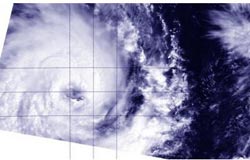NASA sees Tropical Cyclone Bruce still wide-eyed

NASA's Terra satellite passed over the center of Tropical Cyclone Bruce on Dec. 19 at 03:40 UTC and the MODIS instrument captured this image, clearly showing an eye.<br><br>Credit: NRL/NASA<br>
The Moderate Resolution Imaging Spectroradiometer instrument known as MODIS takes amazing visible and infrared images of tropical cyclones, among other things, and captured a good look into the eye of Bruce on Dec. 19 at 03:41 UTC.
Although Bruce's eye seemed to have some high clouds, the eye was still visible. Also visible by MODIS were thick bands of thunderstorms wrapping around the storm's northern quadrant. Convection (rising air that forms the thunderstorms that make up a tropical cyclone) was seen strengthening around the eyewall.
On December 19 at 1500 UTC, Tropical Cyclone Bruce's maximum sustained winds were near 90 knots/103.6 mph/166.7 kph. Bruce was centered near 12.7 south and 90.7 east, about 330 nautical miles/379.8 miles/611.1 km west of Cocos Island, Australia. It was moving to the west-southwest at 10 knots/11.5 mph/18.5 kph.
Bruce is moving along the northern edge of an elongated area of subtropical high pressure and is expected to continue moving to the west-southwest for another three days according to the Joint Typhoon Warning Center.
Media Contact
More Information:
http://www.nasa.govAll latest news from the category: Earth Sciences
Earth Sciences (also referred to as Geosciences), which deals with basic issues surrounding our planet, plays a vital role in the area of energy and raw materials supply.
Earth Sciences comprises subjects such as geology, geography, geological informatics, paleontology, mineralogy, petrography, crystallography, geophysics, geodesy, glaciology, cartography, photogrammetry, meteorology and seismology, early-warning systems, earthquake research and polar research.
Newest articles

Webb captures top of iconic horsehead nebula in unprecedented detail
NASA’s James Webb Space Telescope has captured the sharpest infrared images to date of a zoomed-in portion of one of the most distinctive objects in our skies, the Horsehead Nebula….

Cost-effective, high-capacity, and cyclable lithium-ion battery cathodes
Charge-recharge cycling of lithium-superrich iron oxide, a cost-effective and high-capacity cathode for new-generation lithium-ion batteries, can be greatly improved by doping with readily available mineral elements. The energy capacity and…

Novel genetic plant regeneration approach
…without the application of phytohormones. Researchers develop a novel plant regeneration approach by modulating the expression of genes that control plant cell differentiation. For ages now, plants have been the…





















